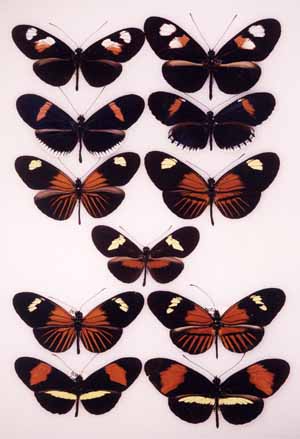 1.
Morphological Species Concept:
1.
Morphological Species Concept:
One of Darwin's principle contributions is the theory of common ancestry - the theory that species are biologically related to one another and are descended from shared ("common" meant as "in common") ancestral species. Darwin's other major contribution - natural selection - describes how this process of divergence might take place: as a consequence of populations adapting to different environments and becoming different from one another. Of course, as Darwin realized, these changes must be heritable - or genetic. We now know that there are a variety of other agents of evolutionary change that can cause change in the genetic structure of a population. All of these changes can, in principle, create enough genetic divergence between populations to render mating, fusion of gametes, or correct development of offspring unlikely. When this occurs, the two populations have achieved "reproductive isolation" - the inability to mate and produce offspring with members of another group. In a genetic sense, this is what we mean by the term 'species'. Although there are situations where this definition is problematic (see below), there is a biological realism to this definition for sexually reproducing organisms. Populations that become reproductive isolated from other groups have a unique biological and genetic identity. Their gene pool is now independent of other genes pools, and changes that occur in this gene pool will be unique (even just by chance genetic drift) and will make this population even more different from other groups. In other words, once a population is reproductively isolated from other groups, it will tend to become even more genetically different and biologically unique.
 1.
Morphological Species Concept:
1.
Morphological Species Concept:
"A species is what a competant taxonomist says is a species", based a sets of characteristics that correlate within a group and not between groups. Often, this is done using lots of characters and a large statistical analysis. In many cases, the analysis and categorization of fossil species or museum specimens still rests on this approach. Although morphology is often a good correlate for biological uniqueness, there are a couple problems that can arise. "Sibling species" are morphological indistinguishable, but genetic analyses reveal that they do not breed with one another. Likewise, polymorphic species are species that harbor morphologically different subpopulations that breed together. Members of these subgroups are often so different that they were classified as separate species until their mating habits and genetic similarity were revealed. For example, in the picture to the right, all the butterflies in the left column are members of the same species, and all the butterflies in the right column are members of a single different species. They do hybridize in one part of their range, creating the morph seen between the columns.
2. Biological Species Concept:
Ernst Mayr, one of the principal authors of the modern synthetic theory and one of the most prominent evolutionary biologists of the 20th century, created the 'biological species concept' in the 1940's. As described above, Mayr defined a species as "a group of organisms that mate among themselves and are reproductively isolated from other such groups." Although this is a biologically attractive definition (because we are trying to identify biological units that differ, and if they don't breed then they do or will differ, genetically), there are some real problems that can occur.
- for many species (fossils and living) the reproductive biology is not described. How shall we classify these organisms?
- for asexual species, reproductive isolation occurs at the clone level...is each clone a species?
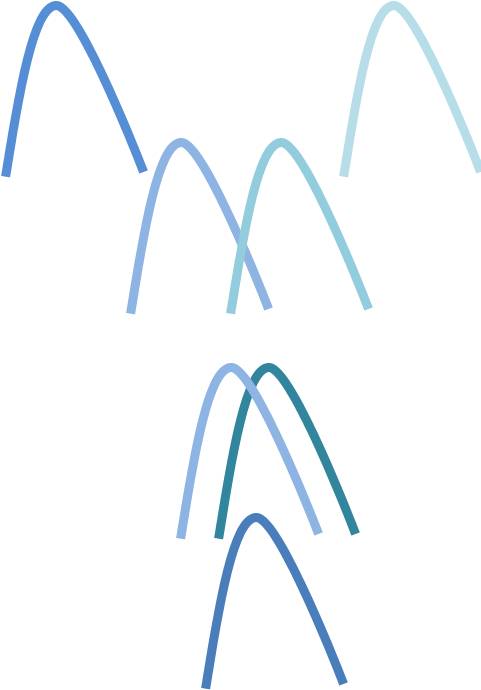 -
finally, we cannot simply use genetic differences as a determinant. Although
reproductive isolation and biological uniqueness correlates with genetic difference,
sometimes single genes can cause populations to become reproductively isolated.
In other cases, genes are transferred laterally - between unrelated organisms
by viruses - and so genetic similarity at a given locus may not indicate recent
ancestry. Indeed, horizontal gene transfer may be so common in prokaryotes that
a pattern of divergence (family 'tree') may be impossible to recreate and may
not be the correct representation of evolutionary relationships, anyway. In
other words, if a lineage receives 30% of its genes from organisms that it is
not decended from, then is "descent with modification" and common
ancestry the most correct and useful and predictive model to describe the evolution
of this group?
-
finally, we cannot simply use genetic differences as a determinant. Although
reproductive isolation and biological uniqueness correlates with genetic difference,
sometimes single genes can cause populations to become reproductively isolated.
In other cases, genes are transferred laterally - between unrelated organisms
by viruses - and so genetic similarity at a given locus may not indicate recent
ancestry. Indeed, horizontal gene transfer may be so common in prokaryotes that
a pattern of divergence (family 'tree') may be impossible to recreate and may
not be the correct representation of evolutionary relationships, anyway. In
other words, if a lineage receives 30% of its genes from organisms that it is
not decended from, then is "descent with modification" and common
ancestry the most correct and useful and predictive model to describe the evolution
of this group?
4. The issue:
The problem of classifying species is caused, in part, with the very process of speciation. Even in a classic case of two isolated populations diverging genetically, this process of genetic divergence may be continuousover timeor space; making the assignment of categorical distinctions problematic. When (or whre across the range) in this continuous process should they be called different species? To name a species is to create a discrete group; however, all biological groups may not be discrete - they may still exhibit some continuous variation with another group - even to the point that they still reproduce at some level (hybridization). This is simply a consequence of how speciation occurs and which genetic differences have occurred.
Well, that obviously depends on how you are classifying them! However, we will proceed with the rest of this lecture applying the biological species concept of Mayr. So, the question changes from 'how does speciation occur?' to 'how does reproductive isolation occur?' Over the years, several 'reproductive isolating mechanisms' have been identified. Typically, these are divided into factors that act before (pre-zygotic) or after (post-zygotic) the formation of a zygote.
1. Pre-zygotic Isolating Mechanisms: What could prevent two populations from mating and forming a zygote?
- Geographic isolation: they are in different places and so do not reproduce. Tigers and lions now have ranges that do not overlap, and so they do not mate in nature - even though they will mate in captivity. For 99.999% of biologists, lions and tigers are still 'good' species.
- Temporal isolation: they are in the same place, but they are active or breed at different times of day or year. Many closely related insects have adapted to different temperature environments, or different host plants that are available at different times, and so they breed a few weeks apart and are reproductively isolated.
- Behavioral isolation: they live in the same place and breed at the same time, but do not recognize one another as suitable mates. Many waterfowl may mate at the same time in the same mating grounds, but they have very elaborate and species-specific courtship rituals that reduce the likelihood of interspecific mating.
- Mechanical isolation: they attempt to mate with each other but their genitalia do not fit. For arthropods with 'lock-and-key' copulatory organs, small changes in the shapes of the organs may result in reproductive isolation.
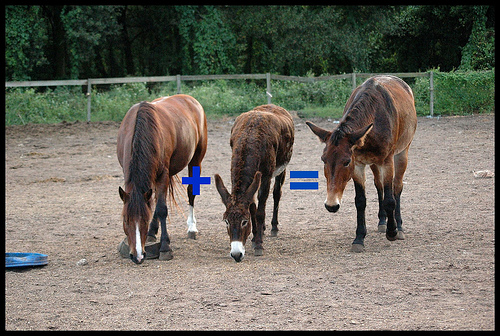 -
Chemical isolation: the sperm may not tolerate the chemical environment of the
female reproductve tract. Chemical isolation is also common in plants, where
the pollen must digest a pollen tube through the style to reach the ovule and
egg. Chemical incompatibility can result when the pollen does not have the correct
digestive enzymes.
-
Chemical isolation: the sperm may not tolerate the chemical environment of the
female reproductve tract. Chemical isolation is also common in plants, where
the pollen must digest a pollen tube through the style to reach the ovule and
egg. Chemical incompatibility can result when the pollen does not have the correct
digestive enzymes.
2. Post-Zygotic Isolating Mechanisms: What cound prevent the zygote from establishing a new population or transferring genes between populations?
- Genomic incompatibility: The zygote forms but the genomes are too different to orchestrate a coordinated development. No embryonic development or incorrect development occurs and no offspring is produced.
- Hybrid sterility: an offspring is produced, but because the chromosomes are not homologous, sexual reproduction is impossible and the hybrid is sterile. So, the two populations can get genes to combine, but they cannot get genes from one population into the other - just into the hybrid. So, the populations are still gnetically isolated from one another. (Donkeys and horses mate to make sterile mules).
- Low hybrid fitness: The hybrid can reproduce, but does so at a lower level than members of the original populations. In this case, the hybrid may be able to transfer genes between populations, but the frequency of hybrids will remain low as they are selected against. Many plants show this pattern. There are many oaks such as Northern red oak, scarlet oak, and southern red oak that hybridize.
1. Radioactive Decay and Geological Clocks
Darwin had guessed that the earth had to be at least 300 million years old to explain the evolution of life through the stately process of natural selection. W. Thompson ("Lord Kelvin") was a physicist who demonstrated that the Earth could be no more than 24 million years old. He did this by calculating how long it would take for a molten object with the Earth's mass to cool to the current temperature of the Earth. However, he made his predictions before Becquerel and the Curies discovered radioactivity - a process that releases heat and keeps the Earth warmer than it "should be" (based on Thompson's inference). After the Curies discovered radium and studied radiactivity (1898), Ernst Rutherford realized that the regular rate of decay could be used to age rocks.
a.
Principle:
- measure amt of parent and daughter isotopes = total initial parental
- with the measureable1/2 life, determine time needed to decay this fraction
- K40-Ar40 suppose 1/2 of total is Ar40 = 1.3by
(Now, you might say "be real"! How can we measure something that is this slow?)
Well, 40 grams of Potassium (K)
contains:
6.0 x 1023 atoms (Avogadro's number, remember that little chemistry
tid-bit?). So, For 1/2 of them to change, that would be:
3.0 x 1023 atoms in 1.3 billion years (1.3 x 109)
So, divide 3.0 x 1023 by 1.3 x 109 = 2.3 X 1014 atoms/year.
Then, divide 2.3 x 1014 by 365 (3.65 x 102) days per year
= 0.62 x 1012 atoms per day ( shift decimal = 6.2 x 1011)
Then, divide 6.2 x 1011 by 24*60*60 = 86,400 seconds/day: (= 8.64
x 104) = 0.7 x 107 atoms per second
0.7 x 107 = 7 x 106 = 7 million atoms changing from Potassium
to Argon every second!!!
This 'decay' gives off energy - radiation that is detectible and measureable by Geiger counters and similar instruments. It is actually an easily measured rate. And you can come back and measure it again tomorrow, next week, next year, or in 50 years; and it has always been the same.
b. Different Clocks
The K-Ar clock is ok for measuring things that happened billions of years ago, but it is not a good clock for things happening hundreds or thousands of years ago because the rate of change is so slow. It would be like measuring an olympic 100m sprint (which last less than 10 seconds these days) with a 2-minute hour-glass egg timer. After ten seconds, only a few grains of sand will have fallen. For measuring anything, you need a gauge with the correct level of resolution. For an olympic 100m sprint, an electronic 'stopwatch' measuring to the thousandths of a second is needed. For measuring the marathon, you don't want that type of resolution; an analog clock that measures hours, minutes, and seconds is probably appropriate. Of course, when you measure the same event with different types of clocks, they should all give roughly the same answer, even if the answers differ in precision. Luckily, there are different isotopic series that give resolution at different time scales:
C14 - decays to C12 with a half-life
of 5730 years
Longer periods - use different elements with longer half-lives
- K40 decays to Ar40 at a rate of 50%/1.3 b years
- U238 - Pb208 = 4.5 by
- Rb87 - St87 = 47 by
- U238 - Thorium 230 = 80,000
- U235 - Protactinium231 = 34,000
c. Tests of Corroboration
We gain greater confidence in a conclusion if it is supported by multiple, independent pieces of evidence. One eyewitness to a crime is ok, but three different people who all tell the same story are far more convincing. Because the decay process in one element present in rock has no effect on the way other elements decay, the decay series are independent of one another. So, one rock could be aged using the K-Ar clock, the Rb-St clock, and the U-Pb clock. If we get roughly the same age using these three different clocks, we would be more confident in that age. There are other corroborating methods, too, that don't involve decay, at all. For example, we can carbon-date material from Pompeii, which we know from historical record should date to 79ACE. Indeed, they do, corroborating the use of radiocarbon dating. One of the most dramatic corroborations involves predictions from astronomers. Astronomers have postulated that, because of tidal friction between the water in the ocean and the earth, the rotation of the Earth has been slowing down over time. In fact, astronomers have calculated that, based on the masses of the oceans and the Earth, and the frictional coefficient of water against land, that the length of an Earth's rotation (a day) has slowed at a rate of 2 seconds every 100,000 years. (So days were SHORTER in the past and have SLOWED to the current 24 period). This process would not affect the time it takes the Earth to orbit the sun, however. So, it would take a year for the Earth to orbit the sun, but the Earth would be spinning on its axis more rapidly in the past. This means that a year in the past would have MORE days than it does now. Indeed, astrophysicists predict that, based on tidal friction, a year 380 million years ago would have contained 400 days. Wow... crazy. Well, corals lay down a layer of calcium carbonate 'shell' every day. There are seasonal changes in the thickness of the layers, so years can be distinguished, too. Some corals have been dated by radioactive decay to be 380 million years old. If this age based on decay is correct, and if the astrophysicists are correct, then they should have 400 daily layers of growth within each yearly band. They do. So, we can use basic physics to predict the "age" of a coral. And when we compare that "age" to the "age" determined by radioactive decay, the ages are the same. So, either they are both true, or they are both wrong in the same way. It is unlikely that we have such basic physics wrong. Very unlikely. So, the Earth is, indeed, very very old. Radioactive decay is constant; if it wasn't, or if it hadn't been in the past, none of these comparisons would work. period. But they DO work, and so it is irrational to conclude that the Earth is young, or that radioactive dating doesn't work or is somehow "dubious". Again, our ability to harness the power of radioactive decay in nuclear reactors is powerful testimony to the degree of confidence we have in our knowledge and understanding of the decay process. And thus, we have great confidence in the great age of the Earth.
2. 'Transitional' fossils
One of Darwin's dilemmas was the lack of continuous sequences of fossils that preserve a complete record of evolutionary change. In 1859, the fossil record was best described as 'discontinuous' for most lineages. Of particular interest to Darwin's model of common descent was the absence of 'transitional' fossils - fossils that showed the nascent beginnings of a major new type of organism evolving from more primitive stock. In the last 150 years, paleontology has unearthed millions of fossils and many have been placed in very complete sequences. They provide a solution to Darwin's dilemma and also allow us to reconstruct phylogenies. We will take a look at some of the more remarkable transitional sequences that have been documented in the evolution of vertebrates.
Transitional fossils are important in two ways. First, they contain a complement of traits that makes them hard to pigeonhole into one group of organisms or another. In other words, they have a combination of traits from two separate groups (an intermediate morphology).
But this is not all. I mean, there are alot of crazy organisms out there. The existence of a weird combination of traits does not mean the organism is necessarily a transitional form, nor does this support common ancestry in and of itself. Evolution does something more than simply predict the existence of transitional forms - if predicts WHEN these forms should exist. Let's apply these ideas to some real fossils.
a. Ichthyostega spp. and the evolution of tetrapods
Darwin hypothesized that amphibians evolved from fish. This created a few important problems - how did lungs and feet evolve? In 1929, several species with a mix of fish and amphibain characters were discovered in Greenland and placed within the genus Ichthyostega. These animals had lungs and gills - an obviously intermediate morphology. And they had tails with cartilagineous rays in the fin, like a fish tail. But these animals also had feet. The legs were probably not strong enough to bear the entire weight of the animal, but it was a true tetrapod. So, it had a suite of fish and amphibian traits. However, that is not enough. To be a transitional fossil and to truly test the hypothesis that this animal is an ancestor of amphibians and a descendant of fish, it must come after true fish and before true amphibians. Indeed, that is right where it is.
This transition between fish and land animals was one of the most important evolutionary transitions in the history of life. Since 1929, many fossils have been found that form a very complete transitional sequence, linking lobe-finned fish like Panderichthyes to proto-amphibians like Ichthyostega and Acanthostega. In 2004, an exceptional fossil was found in Northern Canada that was intermediate between Panderichthyes and Ichthyostega. Tiktaalik rosae was such a beautiful transitional form that it was dubbed the "fish-o-pod". The animal has short bony forelimbs that terminate in fins, not feet. However, the limbs are able to support weight, and have a wrist-like joint that allows the limb to pivot and propel the animal forward. It has a decidedly fish-like body, but an Ichthyostegan head and intermediate limbs.
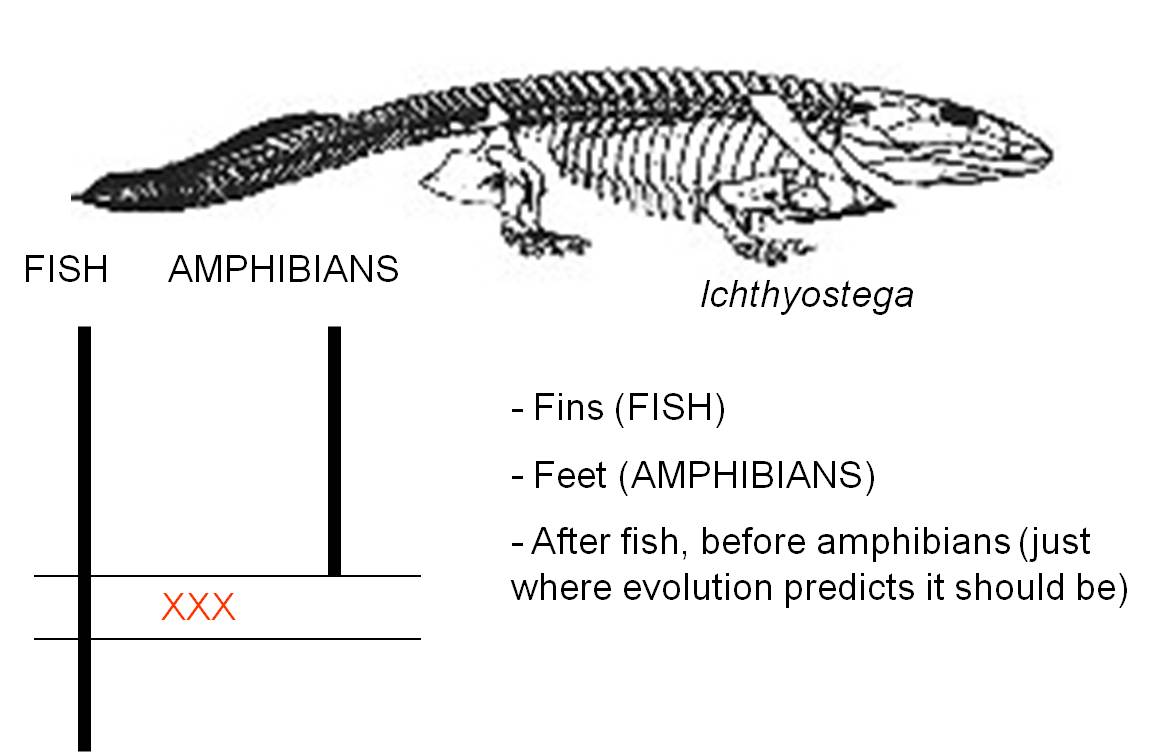 |
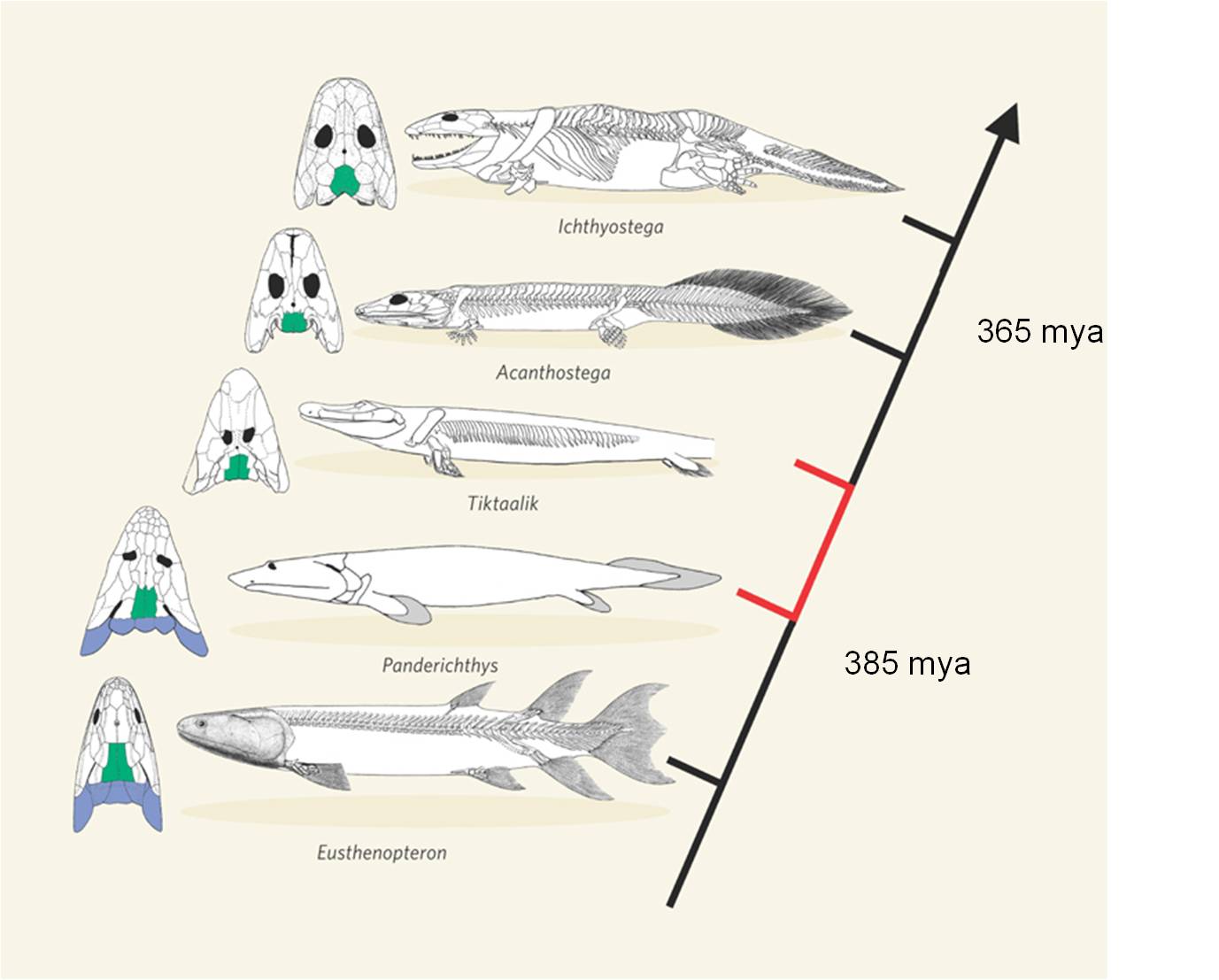 |
| Ichthyostega was one of the first fossils that bridged the gap between fish and amphibians | Now, a series of intermediates shows the transition from ancestral, lobe-finned fishes, through limbed fishes like the "fish-a-pod" Tiktaalik, to amphibians |
b. Archeopteryx lithographica and the evolution of birds
Archeopteryx has an intermediate morphology containing reptilian and avian characteristics. It has fingers, teeth, and a bony tail like reptiles (and unlike birds), but it has feathers like birds (and unlike modern reptiles). So, it had a combination of traits from two major groups. No birds today have teeth or fingers, and no reptiles have feathers. So, it is intermediate in morphology. But evolution PREDICTS something else about this organism. IF it was a biological link between reptiles and birds, then it would have to have lived after other reptiles (who were its ancestors) and BEFORE all true birds (who might be its descendants).
It is. The hypothesis has been tested by evidence from the physical world. Evolution is a testable, supported theory. Indeed, since 1861, further paleontological evidence suggests that birds didn't evolve from just any reptile, but from a specific group called the Maniraptoriformes. This group diverged from the Tyrannosauroidea, which includes Tyrannosaurus rex. Within the maniraptoriformes, we see a wide variety of feathered reptiles discoverd in China since 1990. However, the feathers are not only on the limbs and they are definitely not used for flight. In fact, in the oldest fossils of feathered dinosaurs, the protofeathers are only on the head and spine. A likely scenario is that feathers were first used for attracting mates. Selection for increased feather distribution provided the additional benefit of insulation and homeothermy. Finally, large feathers on the limbs might provide lift while climbing, running, or gliding, and selection could favor the acquisition of flight. This provides a nice example of how a complex trait - flight feathers - might NOT have evolved for that purpose intially.
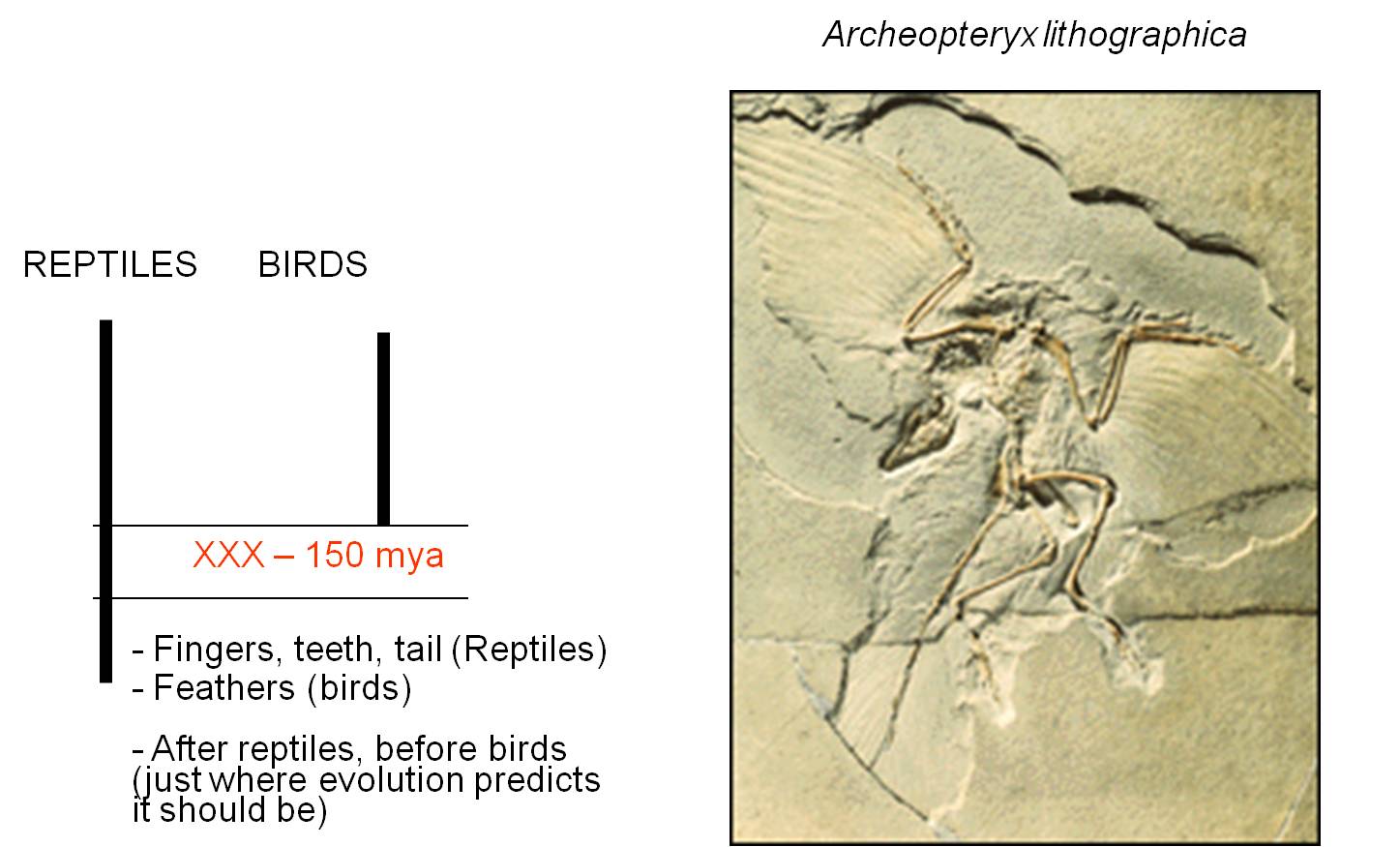 |
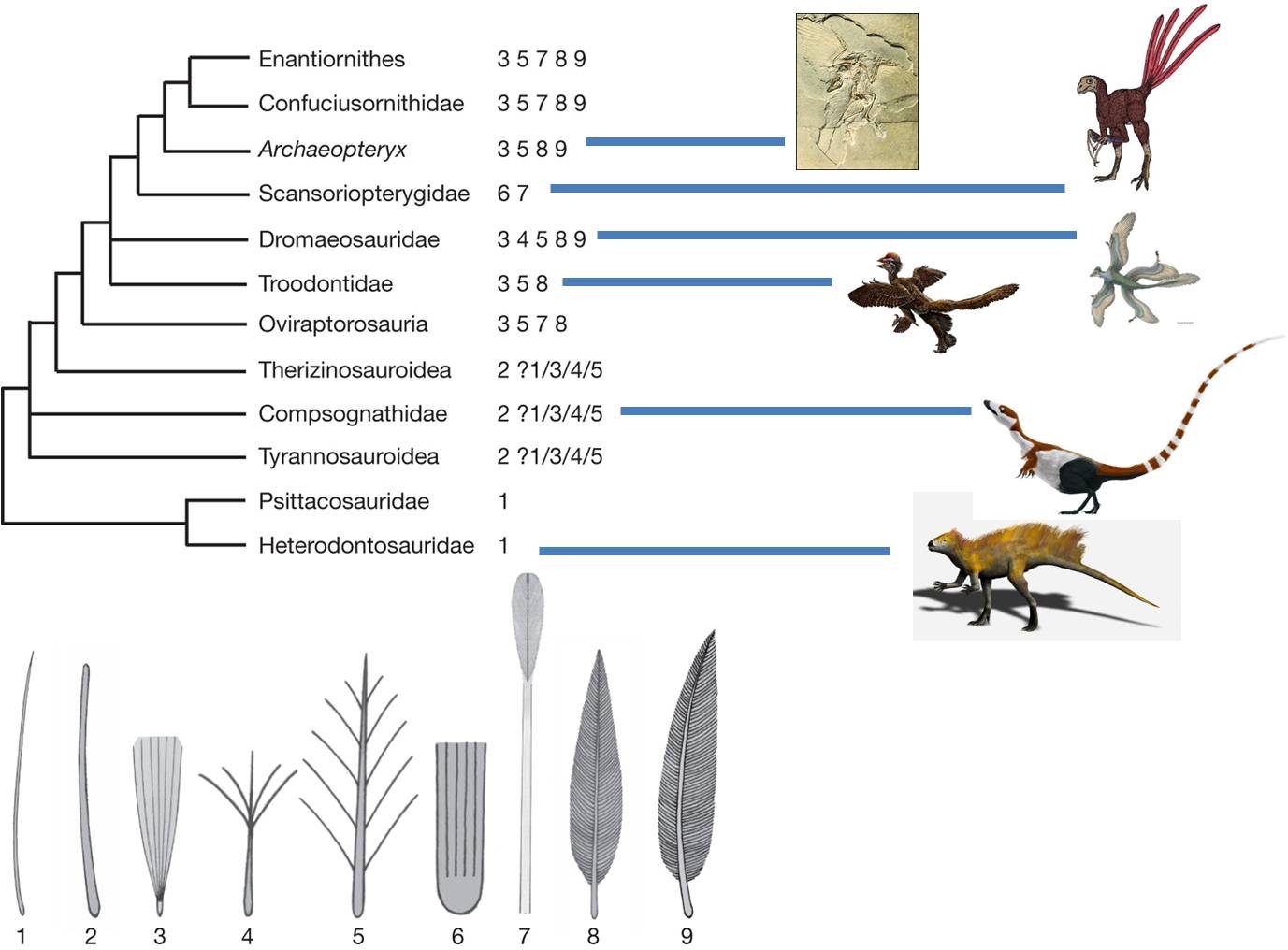 |
| Archaeopteryx was the first intermediate discovered between reptiles and birds. | Now, paleonotologists have found numberous lineages of 'feathered dinosaurs', showing that the lineage leading to Archaeopteryx and modern birds was only one branch of ancestral, feathered animals. |
c. Therapsids and the evolution of mammals
The transition from reptiles to mammals is one of the most well-document transitions in the fossil record. Indeed, there is such a nice sequence that it is difficult to specify where the most important or instructive transition occurs. For our purposes, we will look at a group of organisms called the therapsids. Like reptiles, therapsids have several bones in their lower jaw, and one inner ear bone. Like mammals, they had specialized detition with incisor-like teeth at the front,and larger canines. Also like mammals, they walked with their legs underneath them, rather than out to the side like ancestral reptiles. Through the therapsid lineages, we have a very clear sequence of transitions that show how several of the lower jaw bones of reptiles became reduced and were eventually used as inner ear bones in the mammals. And of course, the therapsids fill the temporal gap between one group of ancestral reptiles and the more modern mammals - just as evolutionary theory and common ancestry predict.
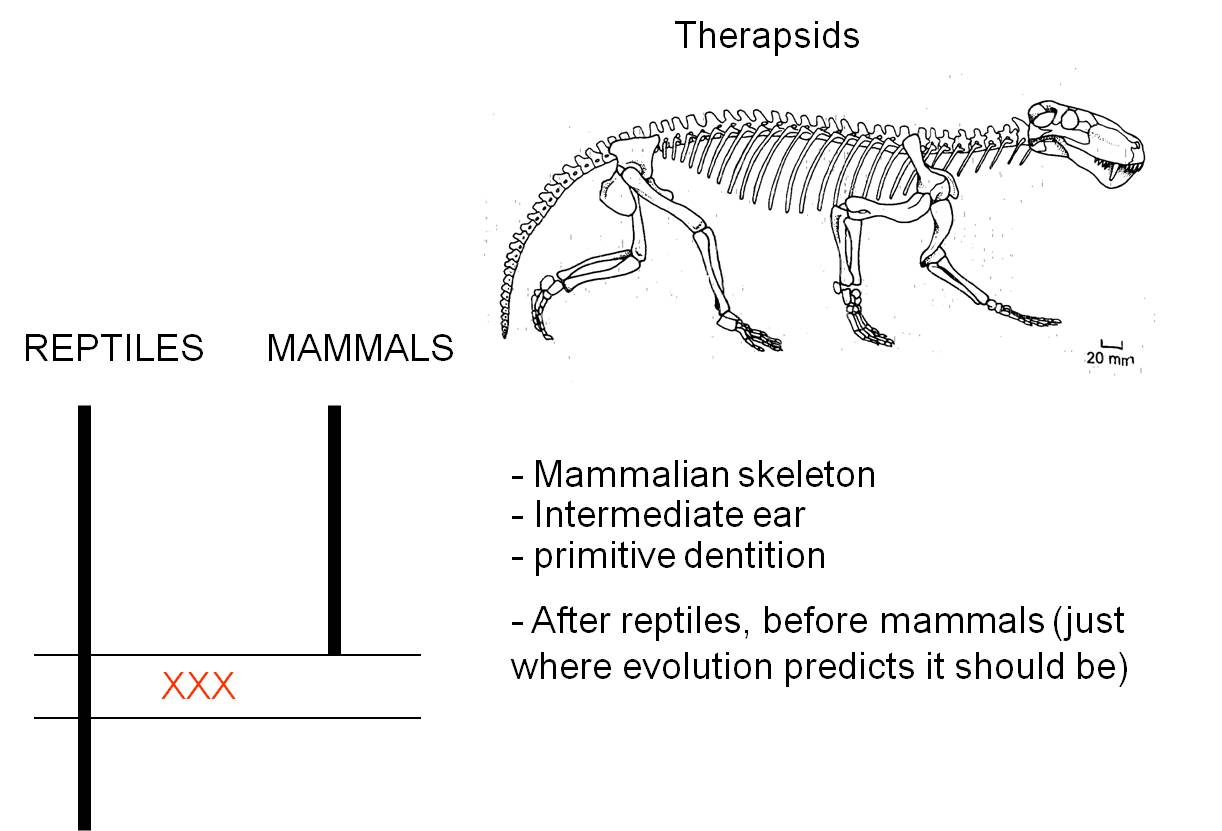 |
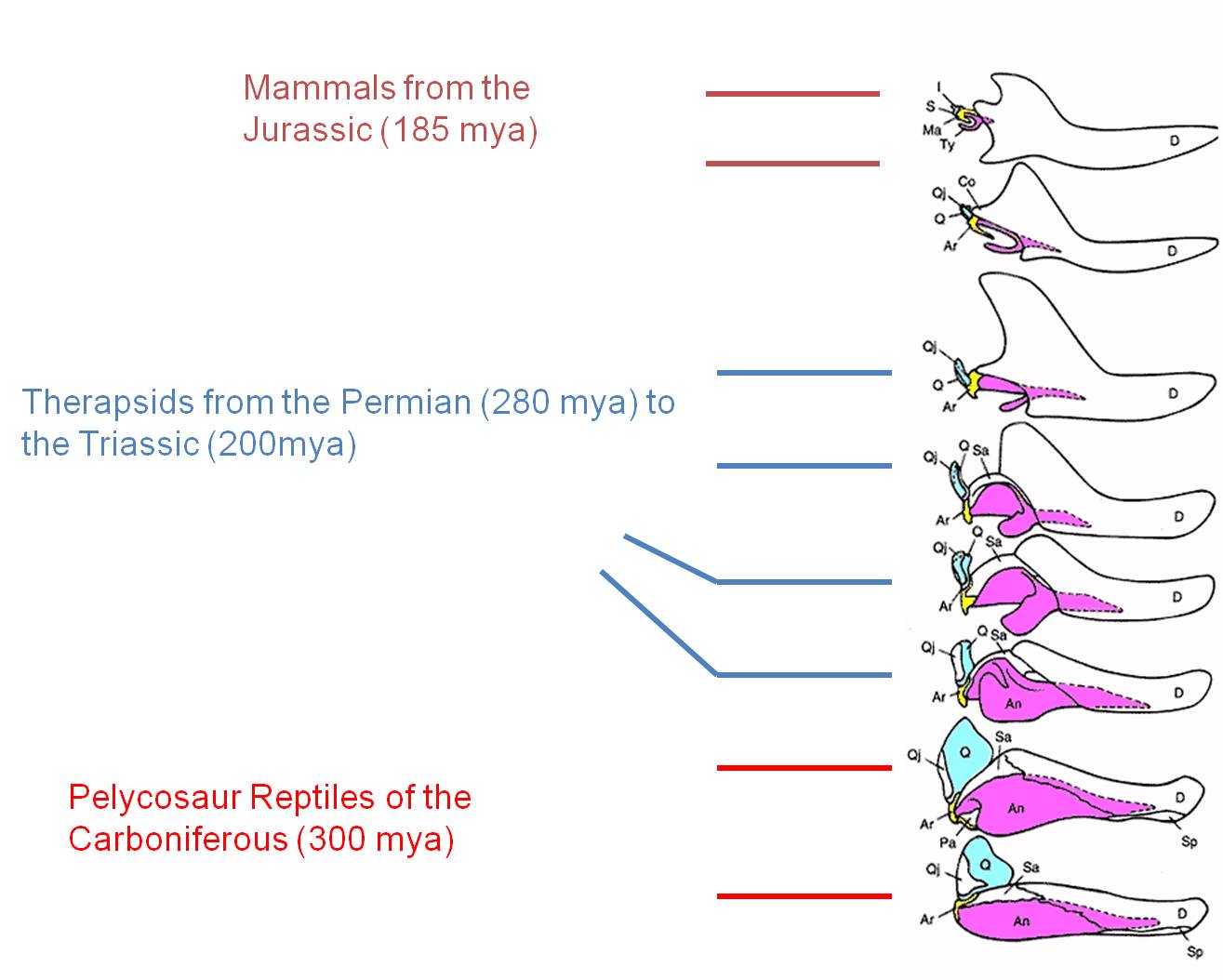 |
| Therapsids were a group of reptiles that dominated during the Permian Period, 250 million years ago. | The evolution of the mammalian middle ear bones is beautifully preserved in the fossil record. The three middle ear bones in mammals (blue, yellow, pink) are homologous and descended from lower jaw bones of reptiles that became reduced in size and took on another function as their role in reptilian jaw function was assumed by the dentary bone (white). |
d. Australopithecines and the evolution of humans
Even Linnaeus recognized the morphological similarity between humans and apes (chimpanzees, gorillas, and orangutans). When we look at these species, the things that set humans apart are our upright stance and bipedal locomotion, our large heads, and our relatively short forelimbs. Ever since the first neanderthal fossil was found in 1856 and after Darwin wrote The Descent of Man in 1871, we have been reconstructing the phylogeny of our own species. There are many fossil species that form an excellent transitional sequence between ancestral primates and modern humans, again making it difficult to pick just one group. However, The Australopithecines provide a good and historically important group. In 1924, Raymond Dart discovered a very small skull of a juvenile primate that he named Australopithecus africanus, meaning "southern man-ape from Africa". Like other australopithecine fossils to follow, it had a short but ape-like snout with reduced canines. Dart suggested that the presence of this fossil in Africa, and the presence of chimps and gorillas in Africa, confirmed Darwin's hypothesis of an African origin of humans. This was highly debated by other anthropologists who believed that humans evolved in Europe or Asia. The discoveries of the Leakey's in Olduvai Gorge in the 1950's and 1960's, and the discovery of Australopithecus afarensis in the 1970's by Donald Johanson, supported the African origins model. The most complete single fossil of A. afarensis, known as the 'Lucy" fossil, shows the combination of traits expected in an intermediate, transitional species. The hip and the articulation of the femur and tibia show that the organism walked erect - a characteristic that is distinctly human. However, the cranial volume is very small - only 25% the volume of modern humans and equal to the volume of chimpanzees. However, other facial features are intermediate; the snout is shorter than in chimps and gorillas, but the canines are much larger than in humans. And again, these fossils fall before more human species and after more primitive primates; just as common ancestry and evolution would predict.
Yes, this is redundant; but it is redundant for a reason. There aren't just one or two fossils that 'conform' to the expectations of evolutionary theory. There are 100's of intermediates that provide tests and confirmation of evolutionary theory. One of the most frequent claims of creationists is that "there are no intermediate fossils". Well, you've seen quite a few, linking the major types of vertebrates. Darwin's theory of common ancestry predicted their existence, and scientists have tested this prediction by looking for physical evidence that could test this hypothesis. Although only Archeopteryx and neanderthals were discovered in his lifetime, we now have intermediates linking all major groups of vertebrates, confirming these hypotheses. It makes you wonder why these claims continue to be made, in the face of such overwhelming physical evidence.
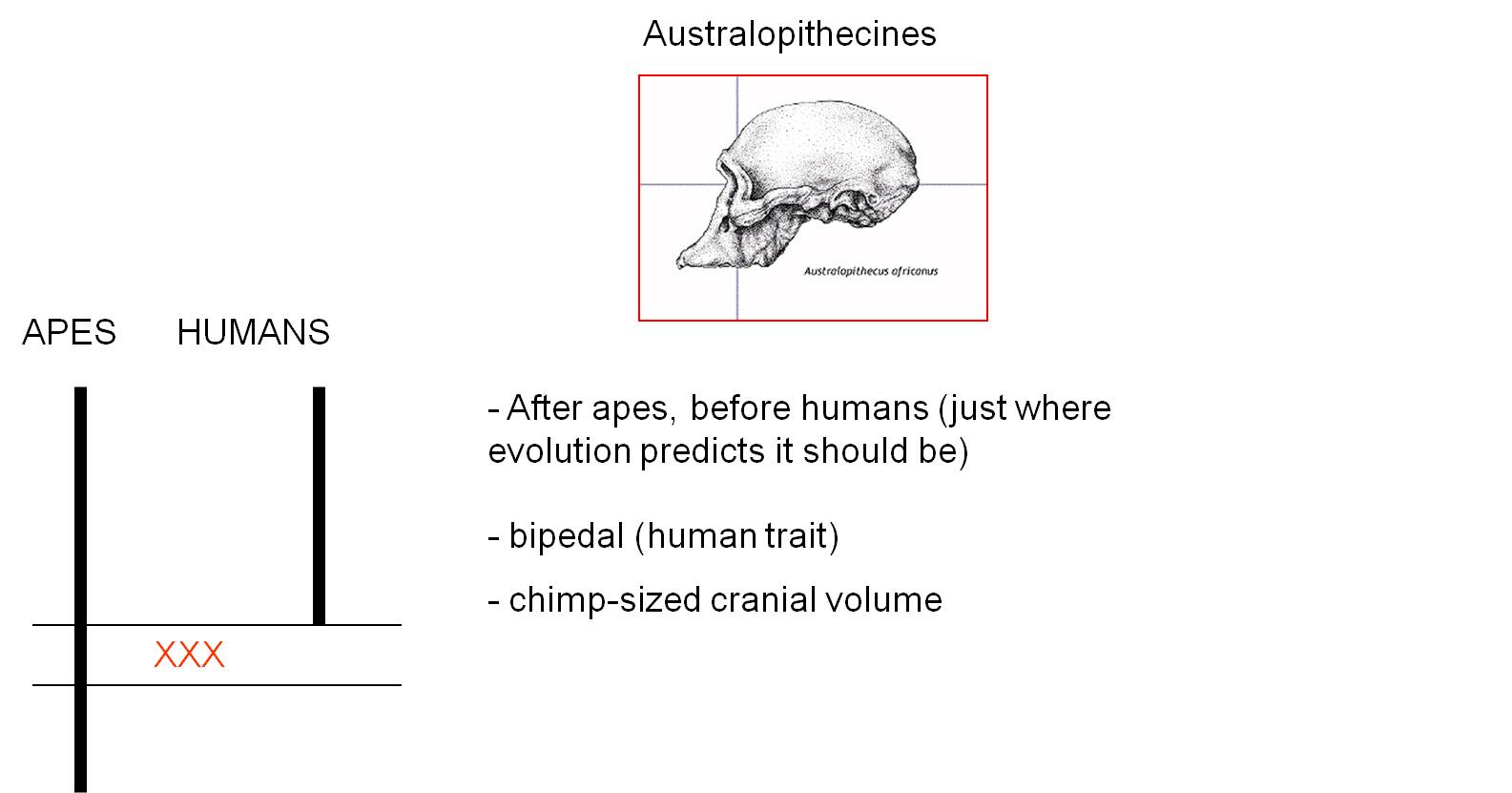 |
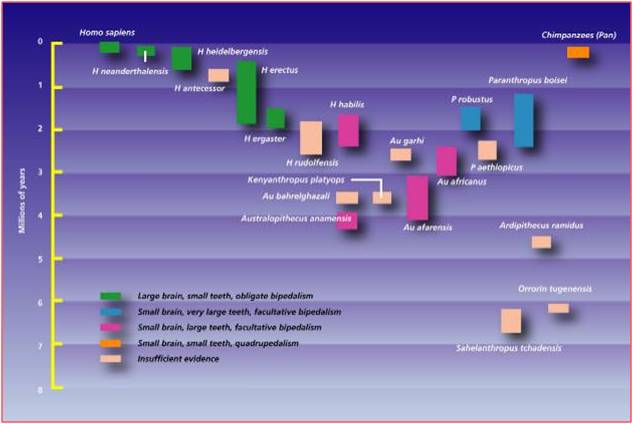 |
| When discovered in 1974, Australopithecus afarensis was the oldest fossil of a bipedal hominid. | Since then, several more primitive bipedal species have been discovered. The fossil history of the hominid lineage has been very well described. |
1. What is a 'morphological species", and what are two problems that arise when we use this method for identifying species?
2. State the 'biological species concept', and state three problems that may arise when we employ this definition.
3. List five pre-zygotic isolating mechanisms and 3 post-zygotic isolating mechanisms.
4. If a rock has a ratio of Ar:K of 7:1, how old is it?
5. How has dating from radioactive decay been corroborated by predictions from astrophysics?
6. What are the two key characteristics of transitional fossils?
7. Why is Ichthyostega considered to be an intermediate fossil?
8. What characteristics make Archaeopteryx an intermediate fossil?
9. What characteristics do therapsids have that make them intermediate fossils?
10. What characteristics do Australopithecines have that make them intermediate fossils?